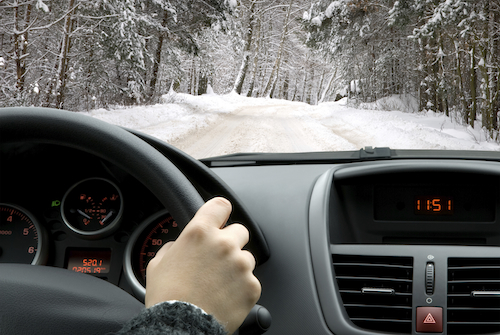New England winters are perfect for making snowmen and playing ice hockey. But the combination of snow, ice, and freezing temperatures makes for hazardous driving conditions. Plan ahead this winter to be sure you, and your vehicle, are prepared. Below are some ideas to help get you started.

Know Your Vehicle
Whether you drive your own car to work every day, or you drive a parish- or school-owned vehicle, always be sure you are familiar with the vehicle you are driving. Does the car have anti-lock brakes (ABS)? Know which safety features are installed in the car and know how to use them.
Is your car in need of a maintenance check? Service your car on a regular basis. Refer to the owner’s manual for recommended tune-up intervals and be sure to follow the recommendations.
Winterize Your Vehicle
- Use snow tires. Snow tires are designed to keep a better grip on snowy and icy surfaces than regular all-season tires. Regular tires tend to get hard and brittle in cold temperatures, but snow tires have softer rubber compounds that retain flexibility in the cold weather.
- Check your tire pressure, especially if your car does not have a built-in tire pressure monitor. Maintaining the correct tire pressure helps stabilize the tire’s structure and enhances responsiveness and traction. Under-inflated tires are more likely to lead to skidding and hydroplaning.
- Check your battery, including the charging system and belts, to be sure there is enough power to start your car on those cold winter mornings.
- Stock up on windshield washer fluid and keep your reservoir full. On snowy days, you may go through a half-gallon or more. Always carry extra fluid in your trunk.
- Make sure you have enough coolant (antifreeze). Use a mixture of 50% coolant and 50% water, and be sure to check for leaks. Even in the winter, a low coolant level can cause your car to overheat.
- Get a tune up. Make sure belts, water pumps and hoses are in working order. You don’t want to find yourself stranded in sub-zero temperatures.
- Carry emergency equipment:
-
- Snow shovel
- Snow brush/ice scraper
- Blanket, hat and glove
- Flashlight
- Towels
- Booster cables
- Orange cones and flares
- Sand or traction mat
- Extra windshield washer fluid
Driving Tips
- Before you head out, remove snow and ice from your windshield, headlights, brake lights, and anywhere else snow has accumulated. Melting snow from other parts of the car can obstruct visibility.
- Try to keep your gas tank full – you never know when you may be stranded in standstill traffic, miles from the nearest gas station. Also, having a tank at least half full helps prevent the fuel line from freezing.
- Roads can become icy when the air temperature falls below 40°F. Be especially careful on bridges and highway overpasses as these areas tend to freeze before the rest of the road and can be slippery.
- Wear your seat belt.
- Wear sunglasses – winter sun on snow and ice can be blinding.
- Plan ahead. Have your directions handy or, if you have a GPS, program it ahead of time so that you will not be fussing with it while driving.
- Drive slowly. Maintain at least 8-10 seconds behind the car in front of you.
- Avoid distractions, especially cell phones and other mobile devices. Even though Massachusetts’ law permits drivers to speak on hands-free devices, a study by the Insurance Institute of Highway Safety (IIHS) finds that the cognitive distraction resulting from having a phone conversation has the same negative effect when using either a hands-free or hand-held device. Studies show that phone conversation tasks typically decreased driver reaction times and increased lane deviations. In hazardous weather, every second of reaction time counts.
- Leave extra time to get where you are going.
- Use your signals and allow time to change lanes.
- Avoid abrupt actions.
Please follow these tips and drive safely this winter season.

